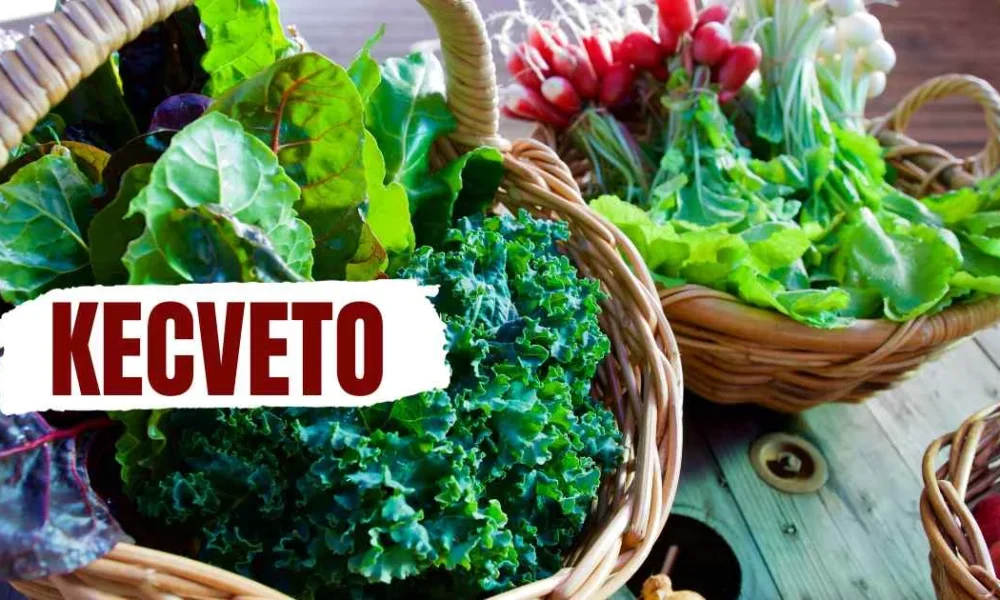Health
Unveiling Kecveto: A Culinary Journey

Introduction to the Flavors of Kecveto
Kecveto – a term steeped in history, culture, and culinary intrigue. But what exactly is Kecveto, and why has it captured the imagination of enthusiasts across the globe?
In this article, we embark on a journey to uncover the essence of Kecveto, exploring its origins, health benefits, cultural significance, and applications in various industries.
Join us as we delve into the depths of this enigmatic concept, unraveling its mysteries and discovering its potential to enrich our lives.
Kecveto, a hidden gem nestled in the heart of Eastern Europe, offers a culinary landscape as rich and varied as its history. This vibrant locale boasts a unique blend of dishes that are steeped in tradition and bursting with flavor. For food enthusiasts and culinary adventurers alike, Kecveto presents an unexplored paradise waiting to be discovered.
Historical Roots of Kecveto’s Cuisine
The culinary traditions of Kecveto trace back to centuries-old practices that have evolved over time, influenced by various cultures and historical events. The foundation of Kecveto’s dishes is built on the hearty and robust flavors typical of Eastern European cuisine, with a distinct twist that sets it apart. From the rustic stews and hearty breads to the delicate pastries and aromatic spices, each dish tells a story of cultural synthesis and culinary innovation.
Signature Dishes of Kecveto
One cannot discuss the culinary offerings of Kecveto without highlighting its signature dishes. These include:
Understanding the History and Origins of Kecveto
Kecveto’s history is a tapestry woven with threads of tradition, innovation, and cultural exchange. To truly appreciate its significance, we must journey back through the annals of time to uncover its origins and trace its evolution.
Ancient Roots:
The roots of Kecveto stretch deep into the past, with evidence suggesting its presence in ancient civilizations spanning Central Europe and beyond. Historians speculate that early practitioners discovered the benefits of slow-cooking meats and vegetables together with a medley of herbs and spices, resulting in a dish that not only nourished the body but also delighted the senses.
Cultural Heritage:
Kecveto’s journey is intertwined with the rich tapestry of Central European culture. Across generations, families have passed down recipes and culinary techniques, each imbued with a sense of pride and heritage. From festive celebrations to everyday meals, Kec-veto has carved a place in the hearts and kitchens of countless individuals, becoming a symbol of cultural identity and tradition.
Trade and Exchange:
As trade routes expanded and cultures mingled, Kecveto underwent a process of evolution, incorporating new ingredients and techniques from distant lands. The exchange of culinary knowledge enriched the dish, adding layers of flavor and complexity that reflected the diversity of the regions it traversed.
Modern Revival:
In recent years, Kecveto has experienced a resurgence in popularity, fueled by a growing interest in traditional cuisines and holistic wellness. Chefs and food enthusiasts alike have embraced Kecveto as a symbol of authenticity and a testament to the enduring appeal of slow-cooked, nutrient-rich meals.
Culinary Heritage Preservation:
Efforts are underway to preserve and promote Ke-cveto’s culinary heritage, with initiatives aimed at documenting traditional recipes, supporting local producers, and celebrating the cultural significance of this time-honored dish. By preserving Ke-cveto’s legacy, we honor the traditions of the past while embracing the possibilities of the future.
In the next sections, we will delve deeper into the ingredients, preparation methods, and health benefits of Kecveto, offering insights into how this ancient dish continues to inspire and nourish us in the modern world.
Exploring Traditional Preparation and Key Ingredients
Kecveto’s allure lies not only in its rich history but also in the meticulous preparation and carefully selected ingredients that define its character. In this section, we delve into the traditional methods of preparing K-ecveto and explore the key ingredients that contribute to its distinctive flavor profile.

Traditional Preparation:
The preparation of Ke-cveto is a labor of love, requiring patience, skill, and attention to detail. At its core, Kecveto is a slow-cooked dish, with ingredients simmered gently over low heat to allow flavors to meld and intensify. Each step of the process is imbued with significance, from the selection of ingredients to the precise timing of cooking.
Key Ingredients:
Central to the art of Kecveto are the ingredients that form its foundation. While variations exist across regions and culinary traditions, certain elements remain constant.
- Meat Selection: Traditional Kecveto often features cuts of beef, pork, or lamb, chosen for their tenderness and flavor. These meats are typically diced or sliced into bite-sized pieces before being added to the pot.
- Vegetables and Spices: A medley of vegetables adds depth and complexity to Kec-veto, with common choices including onions, carrots, potatoes, and tomatoes. Herbs and spices such as paprika, garlic, bay leaves, and thyme are used to season the dish, infusing it with aromatic notes and savory undertones.
- Preparation Techniques: The key to achieving the perfect Kecve-to lies in the art of slow cooking. Ingredients are layered in a large pot or cauldron, allowing them to simmer gently over low heat for several hours. This slow, methodical approach allows flavors to meld together, resulting in a dish that is rich, hearty, and deeply satisfying.
Variations:
While traditional Kec-veto follows a set of time-honored techniques, there is ample room for creativity and innovation. Variations of Kec-veto abound, with each region and household putting its own unique spin on the dish. From the addition of local ingredients to the use of alternative cooking methods, these variations add depth and diversity to the Kecv-eto culinary landscape.
Regional Differences:
The beauty of Kec-veto lies in its ability to adapt and evolve according to local customs and preferences. Across Central Europe and beyond, regional variations of Kec-veto abound, each reflecting the unique culinary heritage of its surroundings. From the hearty stews of Hungary to the aromatic broths of Romania, Kecv-eto manifests in myriad forms, each with its own story to tell.
In the following sections, we will delve deeper into the nuances of K-ecveto, exploring its health benefits, cultural significance, and applications in various industries. Join us as we continue our exploration of this timeless culinary tradition.
Health Benefits and Nutritional Value of Ke-cveto
Beyond its rich flavor and cultural significance, Ke-cveto offers a plethora of health benefits, making it a nourishing choice for both body and soul. In this section, we explore the nutritional value of Kec-veto and delve into its potential to promote overall well-being.
Nutritional Composition:
Kec-veto is a nutrient-dense dish, packed with vitamins, minerals, and essential macronutrients. The combination of meats, vegetables, and herbs creates a balanced meal that provides sustained energy and promotes satiety.
- Proteins: The meat component of Kecveto provides high-quality proteins, essential for muscle repair, immune function, and overall health.
- Vitamins and Minerals: The inclusion of vegetables in Ke-cveto adds a wealth of vitamins and minerals, including vitamin C, vitamin A, potassium, and folate, which are crucial for maintaining optimal health.
- Healthy Fats: While Kecveto is not typically high in fat, the use of lean cuts of meat and minimal added oils ensures that any fats present are of the healthy, unsaturated variety.
Health Benefits:
The consumption of Kecveto is associated with a range of health benefits, thanks to its nutrient-rich ingredients and slow cooking process.
- Boosts Immune System: The combination of meats, vegetables, and herbs in Kecv-eto provides a wide array of immune-boosting nutrients, helping to strengthen the body’s natural defenses against illness and infection.
- Supports Digestive Health: The fiber-rich vegetables and slow-cooked meats in Kec-veto promote healthy digestion and regularity, while also supporting gut microbiome diversity.
- Provides Antioxidant Protection: The vibrant colors of the vegetables used in Kec-veto are indicative of their antioxidant content, which helps to neutralize harmful free radicals and protect against oxidative stress.
- Supports Weight Management: The high protein content and low glycemic index of Ke-cveto make it a satisfying and filling meal, which can help to support weight loss or maintenance goals when consumed as part of a balanced diet.
- Promotes Heart Health: The inclusion of lean meats and heart-healthy vegetables in Kecv-eto supports cardiovascular health by reducing cholesterol levels and promoting optimal blood pressure.
Dietary Considerations:
For those with specific dietary requirements or preferences, Kecv-eto offers flexibility and adaptability.
- Vegetarian Options: While traditional Kec-veto contains meat, vegetarian versions can easily be prepared by omitting the meat and focusing on hearty vegetables, legumes, and grains.
- Gluten-Free: Kec-veto is naturally gluten-free, making it suitable for individuals with celiac disease or gluten sensitivities.
- Low-Carb: With its emphasis on protein-rich meats and nutrient-dense vegetables, Kec-veto can be a suitable option for those following low-carb or ketogenic diets.
In the next sections, we will explore the cultural significance of Ke-cveto, its applications in various industries, and practical tips for incorporating this nutritious dish into your daily life. Join us as we continue our journey through the world of Kec-veto.
Cultural Significance and Practices Associated with Ke-cveto
Kec-veto transcends mere sustenance; it embodies centuries of tradition, culture, and communal celebration. In this section, we delve into the cultural significance of Ke-cveto, exploring its role in traditional celebrations, daily life, and the collective identity of communities.
Kecveto in Traditional Celebrations:
Throughout Central Europe and beyond, Kec-veto holds a place of honor in festive celebrations and gatherings. Whether it’s a wedding feast, a holiday banquet, or a community event, Kec-veto is often the centerpiece of the table, symbolizing abundance, hospitality, and shared joy. The preparation of Kec-veto becomes a communal affair, with family members and friends coming together to lend a hand and share in the anticipation of the feast to come.
Kecveto in Daily Life:
Beyond special occasions, Kec-veto plays a central role in the daily lives of individuals and families across the region. It is a dish steeped in tradition, passed down through generations and cherished as a link to the past. From hearty weekday dinners to leisurely weekend meals, Kec-veto offers nourishment for both body and soul, providing sustenance and comfort in equal measure.
Cultural Traditions and Rituals:
The preparation and consumption of Ke-cveto are often accompanied by a rich tapestry of cultural traditions and rituals. From the selection of ingredients to the cooking methods employed, each step of the process is infused with meaning and significance. These traditions serve to connect individuals to their cultural heritage, reinforcing a sense of identity and belonging.
Symbolism and Identity:
Kecveto serves not only as a source of nourishment but also as a symbol of cultural identity and pride. It is a dish that reflects the values, traditions, and collective memory of a community, embodying the essence of its people and their way of life. Through the sharing of Kecveto, individuals reaffirm their connection to their cultural roots and celebrate the unique flavors and customs that define them.
Passing Down Tradition:
One of the most enduring aspects of Kec-veto is its role as a vehicle for intergenerational transmission of knowledge and culture. Recipes are passed down from parent to child, grandparent to grandchild, preserving the wisdom and traditions of the past for future generations. In this way, Kec-veto becomes more than just a dish; it becomes a link between past, present, and future, ensuring that the spirit of tradition lives on.
In the following sections, we will explore the applications of Ke-cveto in various industries, its impact on sustainability, and emerging trends in Kec-veto cuisine. Join us as we continue our journey through the cultural landscape of Ke-cveto, exploring its diverse manifestations and enduring legacy.
Kecveto in Various Industries: Healthcare, Food, Fashion, and Automotive
Kecveto’s versatility extends beyond the realm of cuisine; it has found applications in diverse industries, each harnessing its unique properties for a variety of purposes. In this section, we explore how Kec-veto has made its mark in healthcare, food, fashion, and even automotive sectors.

Kecveto in the Healthcare Industry:
In recent years, there has been a growing recognition of the health benefits associated with Kecveto consumption. Healthcare professionals and nutritionists are increasingly recommending Kecveto as part of a balanced diet, citing its nutrient-rich ingredients and potential to promote overall well-being. Additionally, Kecveto’s slow-cooking process may enhance the bioavailability of nutrients, making them easier for the body to absorb and utilize.
Kecveto in the Food Industry:
The culinary world has also taken notice of Kecv-eto’s appeal, with chefs and food enthusiasts incorporating it into their menus in various ways. From upscale restaurants to casual eateries, Kec-veto has found its way onto plates around the world, delighting diners with its rich flavors and comforting textures. Additionally, food manufacturers are exploring innovative ways to incorporate Kec-veto into packaged meals and convenience foods, capitalizing on its health halo and consumer demand for nutritious options.
Kecveto in the Fashion Industry:
While perhaps less conventional, K-ecveto has even made its presence felt in the world of fashion. Designers and stylists draw inspiration from the vibrant colors and textures of Kecveto ingredients, incorporating them into clothing, accessories, and even runway shows. The result is a fusion of culinary and sartorial artistry, blurring the lines between food and fashion in unexpected and creative ways.
Kecveto in the Automotive Industry:
In a surprising twist, Kec-veto has also found applications in the automotive sector, albeit in a more unconventional manner. Researchers are exploring the use of Kec-veto-derived biofuels as an alternative to traditional fossil fuels, citing its abundance, renewability, and potential to reduce greenhouse gas emissions. While still in the experimental stages, Kec-veto biofuels represent a promising avenue for sustainable energy production and environmental conservation.
Cross-Industry Collaboration:
One of the most exciting aspects of Ke-cveto’s emergence in various industries is the potential for cross-disciplinary collaboration and innovation. By bringing together experts from disparate fields, such as healthcare, food, fashion, and automotive, Kecveto has become a catalyst for creativity and problem-solving, inspiring new ideas and approaches to age-old challenges.
In the following sections, we will delve deeper into the mechanisms of Ke-cveto’s action in healthcare, its cultural significance in food and fashion, and its potential to drive sustainability initiatives in the automotive sector. Join us as we continue our exploration of Kecveto’s multifaceted impact on the world around us.
How Kecveto Works: Scientific Insights and Mechanisms
While the culinary world has long extolled the virtues of Ke-cveto, recent scientific research has begun to shed light on the mechanisms behind its health benefits. In this section, we delve into the scientific insights and mechanisms that underpin the efficacy of Ke-cveto in promoting overall well-being.
Biochemical Impact:
At the heart of Kecveto’s health-promoting properties lies its complex biochemical composition. The combination of proteins, vitamins, minerals, and phytonutrients in Ke-cveto ingredients exerts a synergistic effect on the body, influencing a wide range of physiological processes.

- Protein Quality: The high-quality proteins found in Ke-cveto ingredients provide the building blocks for muscle repair and growth, as well as supporting immune function and hormone synthesis.
- Antioxidant Activity: The colorful array of vegetables in Kec-veto is rich in antioxidants, compounds that neutralize harmful free radicals and protect cells from oxidative damage, thereby reducing the risk of chronic diseases such as cancer and heart disease.
- Anti-inflammatory Effects: Certain herbs and spices used in Ke-cveto, such as turmeric and ginger, possess anti-inflammatory properties that may help to alleviate inflammation and pain associated with conditions such as arthritis and inflammatory bowel disease.
- Gut Microbiome Modulation: The fiber-rich vegetables and slow-cooked meats in Kecve-to promote a healthy gut microbiome, fostering the growth of beneficial bacteria that support digestion, nutrient absorption, and immune function.
Mechanisms of Action:
Several key mechanisms contribute to Kec-veto’s beneficial effects on health, including:
- Slow Cooking: The slow-cooking process used in Ke-cveto allows flavors to meld and ingredients to break down, enhancing digestibility and nutrient absorption. Additionally, slow cooking may promote the formation of bioactive compounds with potential health benefits.
- Nutrient Synergy: The diverse array of nutrients found in Kec-veto ingredients work together synergistically to promote health and well-being. For example, vitamin C enhances the absorption of iron from meat, while certain fats aid in the absorption of fat-soluble vitamins such as vitamin D.
- Phytochemicals: Many of the herbs, spices, and vegetables used in Kec-veto are rich sources of phytochemicals, bioactive compounds that exert protective effects against disease. These compounds may act as antioxidants, anti-inflammatories, or modulators of cellular signaling pathways involved in disease progression.
Research Overview:
While much is known about the individual components of Kec-veto and their potential health benefits, ongoing research is needed to fully understand its complex effects on human health. Studies examining the impact of Ke-veto on biomarkers of inflammation, oxidative stress, and gut health are currently underway, with promising results indicating its potential as a therapeutic intervention for a variety of health conditions.
In the following sections, we will explore the practical applications of Kecveto in promoting health and well-being, as well as its potential role in disease prevention and management. Join us as we continue our journey through the scientific landscape of Kecveto, uncovering the secrets of its medicinal properties and therapeutic potential.
Applications and Implementations of Kecveto in Daily Life
Armed with knowledge about Kecveto’s origins, health benefits, and cultural significance, individuals can integrate this versatile dish into their daily lives in a variety of ways. In this section, we explore practical applications and implementations of Kecveto, offering insights into how it can be incorporated into everyday routines for optimal health and enjoyment.
Home Cooking:
One of the simplest and most satisfying ways to enjoy Kecveto is by preparing it at home. With a few key ingredients and some basic cooking skills, anyone can whip up a delicious batch of Kecveto in their own kitchen. Whether following a traditional recipe or putting a modern twist on the dish, home cooking allows for complete control over ingredients and flavors, ensuring a personalized and nourishing meal.
Meal Planning:
Incorporating Kecveto into meal planning can streamline the cooking process and ensure a steady supply of nutritious meals throughout the week. Batch cooking large quantities of Kecveto and portioning it out into individual servings makes for convenient grab-and-go meals that can be enjoyed at work, school, or on the go. Additionally, freezing portions of Kecveto allows for long-term storage and easy reheating whenever hunger strikes.
Healthy Eating:
For individuals looking to improve their dietary habits and adopt a healthier lifestyle, Kecveto offers a delicious and nutritious option. Its balanced combination of proteins, vegetables, and herbs makes it a satisfying and filling meal that can help to curb cravings and prevent overeating. By incorporating Kecveto into regular meal rotations, individuals can increase their intake of essential nutrients and promote overall well-being.
Cultural Exploration:
Exploring the world of Kecveto opens doors to new culinary traditions and cultural experiences. Trying out different regional variations of Kecveto allows individuals to taste the diverse flavors of Central Europe and beyond, gaining insight into the customs and traditions of different communities. Whether dining out at a local restaurant or attending a cultural festival, embracing Kecveto offers an opportunity to broaden horizons and connect with others through a shared love of food.
Educational Opportunities:
Learning about Kecveto’s history, ingredients, and preparation methods can be a fun and educational experience for individuals of all ages. From watching cooking demonstrations to attending workshops and culinary classes, there are countless opportunities to deepen understanding and appreciation for this timeless dish. Additionally, exploring Kecveto-related literature, films, and online resources can provide further insights into its cultural significance and culinary legacy.
In the following sections, we will provide practical tips and guidance for cooking Kecveto at home, as well as recommendations for incorporating it into various meals and occasions. Join us as we continue our exploration of Kecveto’s applications in daily life, uncovering the secrets to enjoying this beloved dish to the fullest.
Future Trends, Innovations, and Sustainability Practices
As Kecveto continues to capture the imagination of enthusiasts around the world, it also paves the way for future trends, innovations, and sustainability practices. In this section, we explore emerging trends in Kecveto cuisine, innovative adaptations, and sustainable practices that are shaping the future of this beloved dish.

Emerging Kecveto Flavors:
One of the most exciting trends in Kecveto cuisine is the exploration of new flavors and ingredient combinations. Chefs and home cooks alike are experimenting with innovative twists on traditional recipes, incorporating exotic spices, seasonal produce, and global influences to create unique and exciting variations of Kecveto. From spicy curry-infused stews to fragrant herb-laced broths, the possibilities for flavor exploration are endless.
Technological Advancements in Kecveto Production:
Advancements in technology are revolutionizing the way Kecveto is produced, making it easier and more efficient to prepare this time-honored dish. From high-tech kitchen appliances that automate the slow-cooking process to innovative packaging solutions that extend shelf life and preserve freshness, technology is streamlining every step of the Kecveto production chain. Additionally, digital platforms and mobile apps are connecting Kecveto enthusiasts with recipes, cooking tips, and culinary inspiration from around the world.
Sustainable Practices in Kecveto Preparation:
As concerns about environmental sustainability continue to grow, there is a renewed focus on sustainable practices in Kecveto preparation. Chefs and home cooks are seeking out locally sourced, organic ingredients whenever possible, reducing food waste by using every part of the ingredients, and embracing plant-based alternatives to meat. Additionally, efforts are underway to minimize the carbon footprint of Kecveto production through energy-efficient cooking methods, eco-friendly packaging, and waste reduction initiatives.
Cultural Preservation and Revitalization:
In an increasingly globalized world, there is a growing appreciation for traditional cuisines and cultural heritage. As a result, there is renewed interest in preserving and revitalizing traditional Kecveto recipes, techniques, and culinary traditions. Cultural institutions, culinary academies, and grassroots organizations are working to document, promote, and celebrate the rich cultural heritage of Kecveto, ensuring that it continues to be enjoyed by future generations.
Community Engagement and Collaboration:
Perhaps the most significant trend in the future of Kecveto is the emphasis on community engagement and collaboration. Across the globe, Kecveto enthusiasts are coming together to share recipes, swap cooking tips, and celebrate the joys of food and fellowship. From social media groups and online forums to local cooking clubs and community events, Kecveto is fostering connections and building bridges between people from all walks of life.
In the following sections, we will delve deeper into the practical implications of these emerging trends, offering guidance on how individuals can incorporate them into their own lives and communities. Join us as we continue our exploration of the future of Kecveto, uncovering the innovations and practices that will shape its legacy for years to come.
- Borshch Kecvetinski: A vibrant beetroot soup that combines the earthy tones of local beets with the tartness of vinegar and a rich meat broth. This soup is often served with a dollop of sour cream and a sprinkling of fresh dill.
- Platski: These are savory pancakes made from grated potatoes, onions, and carrots, fried until crispy and golden. Platski are typically served with a side of apple sauce or a creamy garlic sauce, making them an irresistible treat.
- Sernik Kecvetinski: A decadent cheese dessert, akin to cheesecake, made from a special type of farmer’s cheese found only in Kecveto. It’s sweetened with honey and often studded with raisins or nuts.
Innovative Culinary Techniques in Kecveto
Kecveto’s chefs are renowned for their innovative culinary techniques that transform simple ingredients into exquisite meals. Techniques such as slow-cooking stews to perfection, expertly fermenting vegetables for pickles, and baking using traditional methods passed down through generations, are commonplace in Kecveto’s kitchens. These methods not only enhance the flavors but also preserve the nutritional values of the food, making each meal not only delicious but also wholesome.
Seasonal and Locally Sourced Ingredients
The philosophy of using seasonal and locally sourced ingredients lies at the heart of Kecveto’s culinary practices. The region’s fertile plains and favorable climate contribute to the abundant availability of a variety of fruits, vegetables, and grains, ensuring that the ingredients are as fresh and flavorful as possible. This not only supports local farmers and the economy but also reduces the ecological footprint of the food supply chain.
Culinary Festivals and Events in Kecveto
Kecveto is also home to numerous culinary festivals and events throughout the year, which showcase the rich culinary heritage and vibrant food scene of the region. These festivals provide a platform for both established and emerging chefs to demonstrate their culinary prowess and for locals and tourists alike to indulge in these gastronomical delights.
Kecveto’s Impact on Modern Culinary Arts
The culinary influence of Kecveto extends beyond its borders, impacting the modern culinary arts. Many chefs trained in Kecveto have ventured globally, taking with them the unique flavors and techniques that define Kecveto’s cuisine. This has led to a growing appreciation and incorporation of Kecveto’s culinary concepts in international culinary circles, further elevating its status in the global gastronomy community.
Conclusion: A Journey Worth Taking
Exploring the culinary landscape of Kecveto is indeed a journey worth taking. From its deep-rooted traditions to its innovative practices and sustainable approach to food, Kecveto offers a rich tapestry of flavors that are both a tribute to its past and a beacon for its future. Whether you are a seasoned food lover or a curious traveler, Kecveto promises an unforgettable culinary adventure that will tantalize your taste buds and enrich your cultural understanding.
In conclusion, Kecveto transcends its role as a mere dish; it embodies a rich tapestry of history, culture, and culinary innovation. From its ancient origins to its modern-day applications in various industries, Kecveto has captivated the hearts and palates of people around the world. As we’ve explored its health benefits, cultural significance, and future trends, it’s clear that Kecveto holds a special place in both the culinary landscape and the collective imagination.
Whether enjoyed as a comforting home-cooked meal, a gourmet delicacy, or a symbol of cultural identity, Kecveto continues to inspire and nourish us in ways that extend far beyond the dinner table. As we embrace the timeless wisdom of this beloved dish, we embark on a journey of discovery, connection, and culinary delight that enriches our lives and brings us closer together as a global community.
FAQs
1. FAQ: What makes Kecveto different from other slow-cooked dishes?
Answer: Kecveto stands out for its unique blend of ingredients and cultural heritage. While other slow-cooked dishes may focus on specific meats or regional flavors, Kecveto incorporates a diverse array of meats, vegetables, and herbs, reflecting the culinary traditions of Central Europe and beyond. Additionally, the slow-cooking process allows flavors to meld and intensify, resulting in a dish that is rich, hearty, and deeply satisfying.
2. FAQ: Is Kecveto suitable for vegetarians or vegans?
Answer: Absolutely! While traditional Kecveto recipes typically feature meats such as beef, pork, or lamb, it is entirely possible to create delicious vegetarian or vegan versions. Simply omit the meat and focus on hearty vegetables, legumes, and grains to create a plant-based alternative that is equally satisfying and nutritious.
3. FAQ: Can I make Kecveto in advance and freeze it for later?
Answer: Yes, Kecveto is an excellent candidate for batch cooking and freezer storage. Once prepared, allow the Kecveto to cool completely before portioning it out into individual servings and transferring them to freezer-safe containers. Kecveto can be frozen for up to three months, making it a convenient option for busy weeknights or meal prep.
4. FAQ: Are there any health considerations to keep in mind when consuming Kecveto?
Answer: While Kecveto is generally a nutritious and wholesome dish, it’s essential to be mindful of portion sizes and ingredient choices, especially if you have specific dietary restrictions or health concerns. Opt for lean cuts of meat, incorporate plenty of vegetables, and be mindful of added fats and sodium. As with any dish, moderation is key to enjoying Kecveto as part of a balanced diet.
5. FAQ: How can I find authentic Kecveto recipes and cooking tips?
Answer: Authentic Kecveto recipes and cooking tips can be found in a variety of sources, including cookbooks, culinary websites, and online forums dedicated to traditional cuisine. Additionally, reaching out to friends or family members from Central European backgrounds may yield valuable insights and family recipes passed down through generations. Experimenting with different recipes and techniques is all part of the journey of discovering the joys of Kecveto cooking!
Health
Revitalizing Health with Wellhealthorganic.com:Buffalo Milk

In the quest for optimal health and wellness, the choices we make regarding our diet play a pivotal role. Among the myriad options available, buffalo milk stands out as a nutritious and wholesome choice, offering a range of benefits that contribute to overall well-being. At wellhealthorganic.com, the focus on quality and sustainability ensures that every sip of buffalo milk is not just a refreshment but a step towards revitalizing health.
The Nutritional Powerhouse of Buffalo Milk
Buffalo milk is renowned for its rich nutritional profile, making it a valuable addition to any diet. Here are some key nutrients found in buffalo milk:
- Protein: Buffalo milk contains a higher protein content compared to cow’s milk, making it an excellent choice for those looking to boost their protein intake.
- Calcium: It is a significant source of calcium, vital for maintaining strong bones and teeth.
- Vitamins: Buffalo milk is rich in essential vitamins such as vitamin A, D, and B-complex vitamins, which support various bodily functions.
- Minerals: It is also packed with minerals like phosphorus, magnesium, and potassium, essential for overall health and well-being.
Health Benefits of Consuming Buffalo Milk
- Bone Health: The calcium and phosphorus content in buffalo milk contribute to maintaining healthy bones and preventing conditions like osteoporosis.
- Muscle Growth and Repair: The high protein content supports muscle growth, repair, and recovery, making it an ideal choice for athletes and fitness enthusiasts.
- Heart Health: Studies suggest that buffalo milk’s composition may help in lowering cholesterol levels, thereby promoting heart health.
- Digestive Health: The presence of probiotics and beneficial enzymes in buffalo milk can aid digestion and promote a healthy gut microbiome.
Sustainability and Ethical Practices at wellhealthorganic.com
Apart from its nutritional superiority, buffalo milk from wellhealthorganic.com is sourced through sustainable and ethical practices. The commitment to organic farming ensures that the milk is free from harmful chemicals, antibiotics, and synthetic hormones. This not only benefits the consumers but also supports environmental conservation and animal welfare.
Incorporating Buffalo Milk into Your Diet
There are numerous ways to enjoy the goodness of buffalo milk in your daily diet:
- As a Beverage: Enjoy a glass of refreshing buffalo milk on its own or use it as a base for smoothies and shakes.
- In Cooking: Use buffalo milk to prepare creamy sauces, desserts, and baked goods for a rich and flavorful touch.
- With Cereals and Grains: Pour buffalo milk over cereals, oats, or porridge for a nutritious breakfast option.
Conclusion
In conclusion, buffalo milk from wellhealthorganic.com is not just a beverage but a symbol of health, sustainability, and ethical practices. Its nutritional richness, coupled with the commitment to quality, makes it a standout choice for individuals looking to enhance their well-being through mindful dietary choices. Embrace the goodness of buffalo milk and embark on a journey towards holistic health and vitality.
FAQs:
- Is buffalo milk suitable for lactose-intolerant individuals?
- While buffalo milk contains lactose, some lactose-intolerant individuals find it easier to digest compared to cow’s milk. It’s best to consult a healthcare professional for personalized advice.
- Can buffalo milk be used for making cheese and yogurt?
- Yes, buffalo milk is commonly used for making various dairy products such as cheese, yogurt, and butter due to its rich and creamy texture.
- Is buffalo milk suitable for children?
- Buffalo milk can be a nutritious option for children, providing essential nutrients for growth and development. However, moderation is key, especially for young children.
- How does buffalo milk compare to cow’s milk in terms of taste?
- Buffalo milk has a richer and creamier taste compared to cow’s milk, making it a preferred choice for those who enjoy a fuller flavor profile.
- Is buffalo milk environmentally friendly?
- Yes, buffalo milk production is often considered more environmentally friendly than cow’s milk production, as buffaloes are more efficient in converting feed into milk and require less water and land resources.
Health
Ayurvedic Health Tips for Well-Being

Ayurveda, the ancient system of medicine originating in India, offers a holistic approach to health and well-being. In today’s fast-paced world, where stress and lifestyle-related diseases are on the rise, incorporating Ayurvedic principles into our lives can lead to profound improvements in overall health. Let’s delve into some Ayurvedic health tips for a well-balanced life.
1. Introduction to Ayurveda
Ayurveda, often referred to as the “science of life,” dates back thousands of years and is based on the belief that health and wellness depend on a delicate balance between the mind, body, and spirit. Its fundamental principles revolve around the concept of achieving harmony with nature and understanding individual constitution.
2. Understanding Well-Being in Ayurveda
In Ayurveda, well-being is viewed holistically, encompassing physical, mental, and spiritual aspects. Central to this philosophy are the three doshas: Vata (air and space), Pitta (fire and water), and Kapha (earth and water). Each person has a unique combination of these doshas, which influences their physical and psychological characteristics.
3. Ayurvedic Lifestyle Tips
Ayurveda emphasizes the importance of daily and seasonal routines (Dinacharya and Ritucharya) to maintain balance and harmony with nature. This includes practices such as waking up early, practicing yoga and meditation, and eating meals at regular intervals.
4. Dietary Guidelines
Diet plays a crucial role in Ayurveda, as it is believed to be the foundation of good health. Ayurvedic dietary guidelines recommend consuming fresh, seasonal foods that are suited to one’s dosha constitution. For example, individuals with a Pitta imbalance should favor cooling foods, while those with a Vata imbalance may benefit from warm, nourishing meals.
5. Herbal Remedies and Supplements
Ayurveda harnesses the healing power of herbs and natural supplements to promote overall health and well-being. Common herbs such as turmeric, ashwagandha, and triphala are known for their antioxidant and immune-boosting properties.
6. Yoga and Exercise Recommendations
Yoga, an integral part of Ayurveda, offers a multitude of benefits for both physical and mental health. Practicing yoga asanas tailored to one’s dosha type can help balance the body and mind, improve flexibility, and reduce stress.
7. Stress Management Techniques
In Ayurveda, stress is viewed as a significant contributor to disease. Meditation, mindfulness practices, and the use of adaptogenic herbs such as holy basil and brahmi can help alleviate stress and promote emotional well-being.
8. Promoting Digestive Health
According to Ayurveda, a healthy digestive system is the cornerstone of good health. Incorporating dietary habits such as eating mindfully, favoring warm, cooked foods, and avoiding incompatible food combinations can support optimal digestion.
9. Quality Sleep Practices
Adequate and restful sleep is essential for maintaining balance in Ayurveda. Establishing a relaxing bedtime routine, creating a conducive sleep environment, and avoiding stimulating activities before bed can help promote quality sleep.
10. Detoxification and Cleansing
Ayurveda advocates periodic detoxification and cleansing to rid the body of accumulated toxins (ama) and restore balance. Practices such as fasting, herbal cleanses, and Panchakarma therapies can rejuvenate the body and mind.
11. Natural Skincare and Beauty Tips
Ayurveda offers natural and holistic approaches to skincare, emphasizing the use of herbs, oils, and seasonal rituals to enhance beauty from within. Incorporating practices such as oil massage (abhyanga) and herbal facials can nourish the skin and promote a youthful glow.
12. Managing Chronic Health Conditions
Ayurveda provides personalized treatments for a wide range of chronic health conditions, including digestive disorders, arthritis, and stress-related ailments. Integrating Ayurvedic therapies with conventional medicine can offer comprehensive and holistic care.
13. Preventive Healthcare
Preventive healthcare is a cornerstone of Ayurveda, focusing on maintaining balance and preventing disease before it manifests. By incorporating Ayurvedic practices into daily life, individuals can proactively promote long-term health and wellness.
14. Seeking Professional Guidance
While Ayurveda offers valuable insights into health and well-being, it’s essential to consult with a qualified Ayurvedic practitioner for personalized guidance. A trained practitioner can assess one’s unique constitution and recommend tailored lifestyle modifications and herbal remedies.
15. Conclusion
Incorporating Ayurvedic health tips into your daily routine can pave the way for a healthier, more balanced life. By nurturing harmony between mind, body, and spirit and embracing the wisdom of Ayurveda, you can embark on a journey towards optimal well-being.
FAQs
- Is Ayurveda safe for everyone?
- How long does it take to see results with Ayurvedic practices?
- Can Ayurveda treat chronic health conditions?
- Are Ayurvedic supplements regulated?
- How do I find a qualified Ayurvedic practitioner?
Health
WELLHEALTH HOW TO BUILD MUSCLE TAG: A GUIDE TO A HEALTHIER YOU

Introduction to Building Muscle
In today’s wellness-conscious society, the pursuit of a healthier lifestyle often involves building muscle. Beyond the aesthetic appeal of a toned physique, strong muscles contribute significantly to overall health and vitality. However, embarking on a muscle-building journey requires more than just lifting weights; it entails a holistic approach that encompasses nutrition, exercise, and rest.
Understanding the Importance of Muscle Health
Muscles are not just for bodybuilders or athletes; they play a crucial role in everyday activities, from lifting groceries to climbing stairs. Maintaining adequate muscle mass is essential for preserving mobility, preventing injury, and supporting metabolic function.
Benefits of Building Muscle
Building muscle offers a myriad of benefits beyond aesthetics. It increases metabolism, aiding in weight management and fat loss. Additionally, strong muscles enhance bone density, reducing the risk of osteoporosis, and improve insulin sensitivity, lowering the chances of developing type 2 diabetes.
Setting Goals for Muscle Building
Before embarking on a muscle-building journey, it’s essential to set clear and achievable goals. Whether aiming for increased strength, muscle definition, or overall fitness, defining objectives provides direction and motivation.
Defining Realistic and Achievable Goals
Set specific, measurable, attainable, relevant, and time-bound (SMART) goals to ensure success. Consider factors such as current fitness level, lifestyle constraints, and personal preferences when establishing targets.
Importance of Setting a Timeline
Having a timeline creates a sense of urgency and accountability, preventing procrastination and ensuring consistent progress. Break long-term goals into smaller milestones to track achievements effectively.
Nutrition for Muscle Growth
Nutrition plays a pivotal role in muscle development, providing the building blocks necessary for repair and growth. A well-balanced diet rich in protein, carbohydrates, healthy fats, vitamins, and minerals is essential for optimizing muscle-building potential.
Protein-Rich Diet
Protein is the cornerstone of muscle growth, as it provides the amino acids needed for muscle repair and synthesis. Incorporate lean sources of protein such as chicken, fish, tofu, beans, and legumes into your meals to support muscle recovery and growth.
Essential Nutrients for Muscle Development
In addition to protein, ensure adequate intake of carbohydrates for energy, healthy fats for hormone production, and micronutrients such as vitamins and minerals for overall health and performance.
Effective Workout Routines
A well-designed workout routine is crucial for stimulating muscle growth and strength gains. Focus on compound exercises that target multiple muscle groups simultaneously, incorporating both resistance training and cardiovascular activities for optimal results.
Resistance Training
Include exercises such as squats, deadlifts, bench presses, and rows to build strength and muscle mass effectively. Gradually increase the intensity and volume of your workouts to challenge your muscles and promote growth.
Incorporating Cardio for Overall Health
While resistance training is paramount for muscle building, don’t neglect cardiovascular exercise for cardiovascular health and calorie expenditure. Aim for a balance between strength training and cardio to achieve a well-rounded fitness regimen.
Recovery and Rest
Rest and recovery are often overlooked but are critical components of the muscle-building process. Allow your muscles adequate time to recover between workouts to prevent overtraining and maximize gains.
Importance of Rest Days
Schedule regular rest days to allow your muscles to repair and rebuild stronger. Listen to your body and prioritize sleep, as adequate rest is essential for muscle recovery and overall well-being.
Muscle Recovery Techniques
Incorporate strategies such as foam rolling, stretching, massage, and contrast baths to enhance recovery and alleviate muscle soreness. Listen to your body’s cues and adjust your training intensity and frequency accordingly.
Avoiding Common Mistakes
In the pursuit of building muscle, it’s essential to avoid common pitfalls that can hinder progress and increase the risk of injury.
Overtraining
While consistency is key, overtraining can lead to burnout, fatigue, and injury. Allow for adequate rest and recovery between workouts, and pay attention to signs of fatigue or stagnation.
Poor Form During Workouts
Maintain proper form and technique during exercises to prevent injury and ensure optimal muscle engagement. Seek guidance from a qualified fitness professional if unsure about proper exercise execution.
Tracking Progress
Tracking progress is essential for staying motivated and assessing the effectiveness of your training program. Keep a detailed workout journal and utilize technology such as fitness apps and wearable devices to monitor metrics such as strength, endurance, and body composition.
Keeping a Workout Journal
Record your workouts, including exercises, sets, reps, and weights lifted, to track progress over time. Reviewing your training history can help identify patterns, set new goals, and celebrate achievements.
Utilizing Technology for Tracking
Take advantage of fitness apps, wearable devices, and online platforms to monitor various aspects of your fitness journey, from nutrition and workouts to sleep and recovery. Set reminders, track trends, and analyze data to optimize your training and lifestyle habits.
Staying Motivated
Maintaining motivation is essential for long-term success in building muscle. Find sources of inspiration, celebrate small victories, and cultivate a positive mindset to overcome challenges and stay committed to your goals.
Finding Inspiration
Surround yourself with supportive peers, mentors, or role models who inspire and motivate you to strive for excellence. Visualize your goals, create a vision board, or seek out success stories to stay inspired and focused on your journey.
Celebrating Small Victories
Acknowledge and celebrate progress, no matter how small, to reinforce positive habits and maintain momentum. Set mini-goals and reward yourself for achieving milestones, whether it’s a new personal record, improved physique, or consistent adherence to your routine.
Conclusion
Building muscle is a rewarding endeavor that requires dedication, consistency, and a comprehensive approach to nutrition, exercise, and recovery. By setting realistic goals, prioritizing proper nutrition and training, and staying motivated, anyone can achieve their desired physique and enjoy the numerous benefits of a healthier, stronger body.
Unique FAQs
- How long does it take to build noticeable muscle?
- The timeline for visible muscle growth varies depending on factors such as genetics, diet, training intensity, and consistency. However, most individuals can expect to see noticeable changes within a few weeks to several months of dedicated training.
- Can I build muscle without lifting weights?
- While resistance training with weights is the most efficient way to build muscle, bodyweight exercises, resistance bands, and other forms of resistance training can also promote muscle growth and strength gains.
- Is it possible to build muscle while losing fat?
- Yes, it’s possible to simultaneously build muscle and lose fat, a process known as body recomposition. To achieve this, focus on maintaining a caloric deficit while prioritizing protein intake and engaging in resistance training.
- Do I need to take supplements to build muscle?
- While supplements can complement a balanced diet and training program, they are not essential for building muscle. Protein powder, creatine, and branched-chain amino acids (BCAAs) are popular supplements that may support muscle growth, but whole foods should always be the primary source of nutrients.
- How important is sleep for muscle growth?
- Adequate sleep is crucial for muscle recovery, hormone regulation, and overall health. Aim for 7-9 hours of quality sleep per night to optimize muscle growth, repair, and performance.
-

 Lifestyle1 month ago
Lifestyle1 month agoGuia Silent Hill Geekzilla: A Travel Guide
-

 Entertainment1 month ago
Entertainment1 month agoRzinho: A Guide to His Life and Career
-

 Sport1 month ago
Sport1 month agoRevolutionizing the Fan Experience: The Evolution of Sports Hospitality
-

 Tech4 weeks ago
Tech4 weeks ago06shj06: Unlocking Its Power and Potential
-

 Tech1 month ago
Tech1 month agoExploring the World of Geekzilla Tech 2024
-

 Health1 month ago
Health1 month agoÇeciir: Exploring the Richness of a Traditional Delicacy
-

 Business1 month ago
Business1 month agoPeúgo: Revolutionizing the Automotive Industry
-

 Health1 month ago
Health1 month agoEverything You Need to Know About Deț
